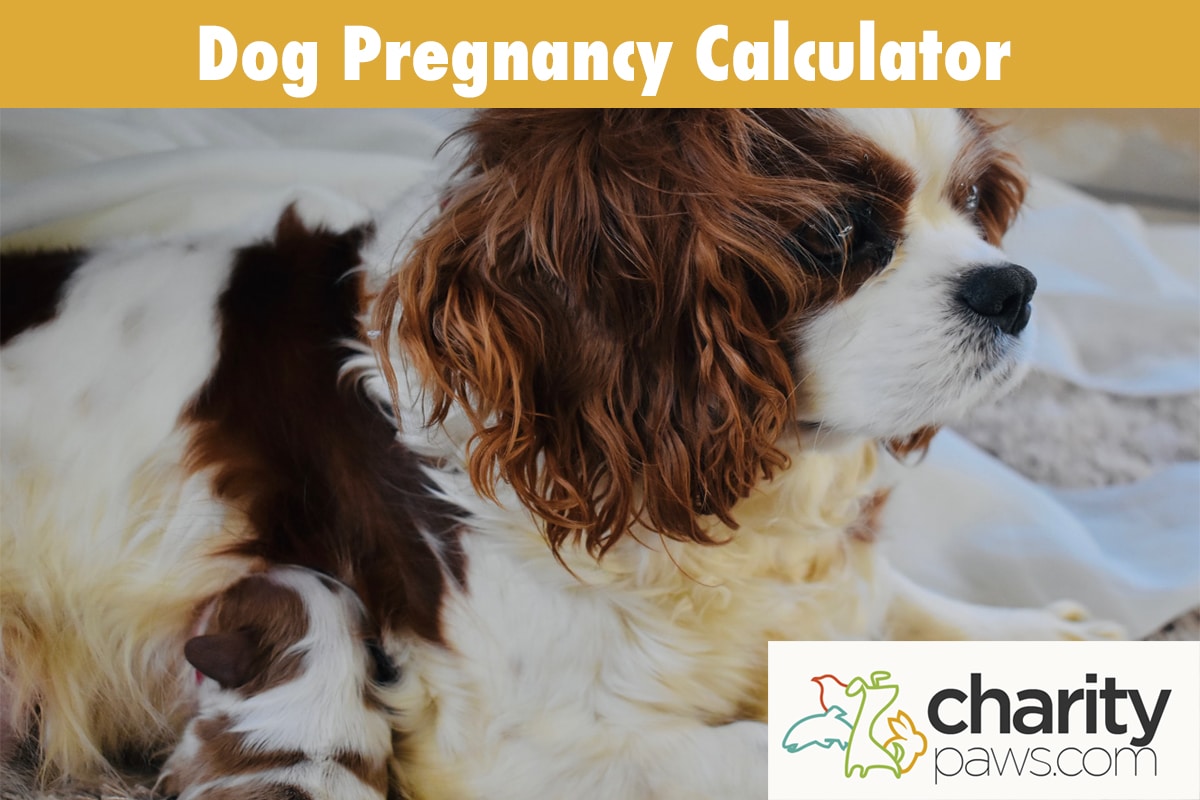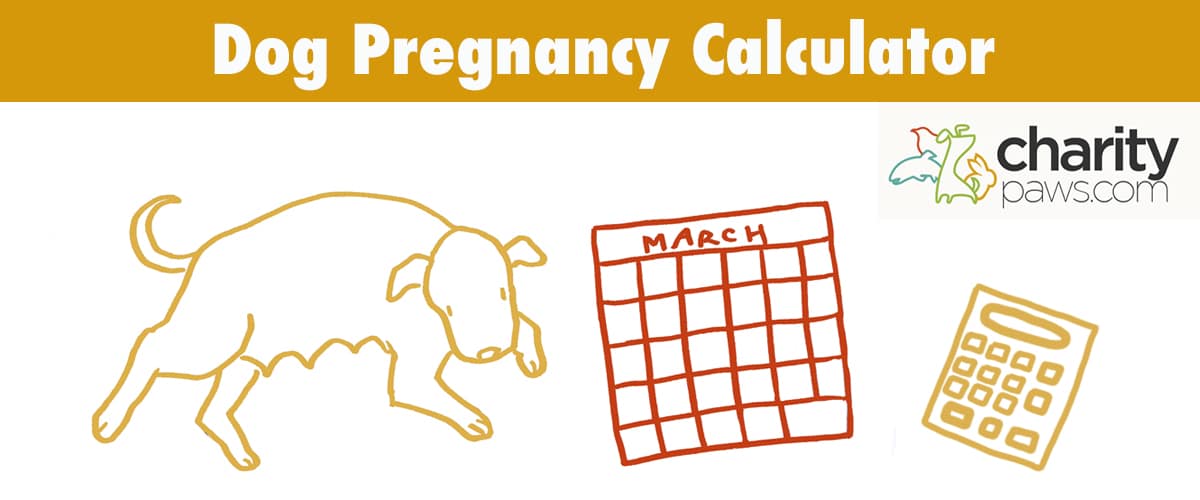If you suspect your dog might be pregnant, then congratulations!
This is an exciting time, but you might have a few questions, particularly if this is the first time you have cared for a pregnant dog.
The most common ones are ‘how long is a dog’s gestation? and ‘when will my dog give birth?’.
In this article, we will look at normal pregnancy length, some tips on how to care for your dog during this time, and what to do when the due date is approaching.
If you have any concerns about your dog at all, then make sure you call your vet for advice.

Use This Dog Pregnancy Calculator To Determine Due Date
Are you looking for an easy way to figure out when your dog will be due to delivery her puppies?
A dog’s gestation period is 63 days, meaning we should be able to give you an idea of when to expect something to start happening by a specific date.
Our dog pregnancy calculator was made to give you an estimated date of delivery as well as a range of dates where your pup could deliver her new babies.
Not all dogs will go exactly 63 days, some will be 61 days while others can go up to 70 days before delivery.
Dog Pregnancy Calculator
Is your dog pregnant and you want to find out when to expect her new babies? Use this dog pregnancy calculator to figure out your dog's due date.
Date of First Mating:
CalculateThe average length of a dog's pregnancy is 63 days. The above date will show you an estimated date of delivery as well as an estimation of the earliest and latest dates of delivery.
*Contact your veterinarian if you have questions or to schedule an appointment, as they will be able to give you an understanding of when your dog may be due.
What Is The Average Length Of A Dog’s Pregnancy?
The average length of pregnancy for a female dog is 63 days plus or minus 2 days.
This has been measured from the day of ovulation, which is not necessarily the same day your dog was mated.
Ovulation is when the female releases her eggs from her ovaries.
Obviously, as a bystander, this is something that is not visible, so without specialist hormone measuring, the average owner simply won’t know exactly when their dog ovulated.
A veterinarian would be required to work out exactly when ovulation is occurring.
This is done through blood samples that look at progesterone or luteinizing hormone levels, or through cell samples from the vagina which are analyzed under the microscope.
Many owners find this expensive or impractical, and instead, they rely on just monitoring their dog’s oestrus symptoms (swollen vulva and a bloody discharge which is turning clear in color) and whether she will stand to be mated by the stud dog.
But if we are trying to measure pregnancy length from the day of mating instead of the day of ovulation, then the results for gestation (pregnancy) length are much more variable.
It may be that your dog ovulated a couple of days before she was mated, or that she ovulated a few days after.
As sperm has 5 or 6 days viability in the female’s reproductive tract it could be that your dog gets pregnant a few days after mating takes place if she ovulates later on, for example.
This means that, in theory, your dog could have her puppies anywhere between around 58 and 68 days post-mating.
Some may even start showing signs of impending labor at day 68, but not actually finish birthing her pups until day 70!
However, despite this variation, the whelping date (or due date) is still usually calculated to be 63 days after the first mating of your dog.
Just don’t rely on the pups turning up on that exact date!
Do All Dog Breeds Have The Same Pregnancy Length?
Despite the variation in size and shape between different breeds of dog, their pregnancy length doesn’t vary much.
One female dog’s reproductive tract operates much in the same way as another’s, so you don’t need to factor in your dog’s breed into your due date calculations.
Signs Of Pregnancy In Dogs
Your dog may show some physical signs, especially as their pregnancy progresses.
- Weight gain, especially in the tummy area
- Increased hunger (more noticeable in the second half of pregnancy)
- Enlargement of the nipples, mammary glands, and milk production
- Changes in energy levels, becoming a bit more sedate than normal
- Behavioral changes, some female dogs will show nesting behaviors and may be a bit more clingy and quiet than usual
Confusingly though, some of these symptoms may be seen in dogs that are undergoing a false pregnancy.
This is caused by a release of hormones after the season.
How To Estimate A Due Date If You Don’t Have A Conception Date
If you don’t know the date of conception (mating), but are suspicious that your female dog is pregnant, then the best thing to do is to get your pet checked over by your veterinarian.
A painless ultrasound scan can be performed, which can be done conscious (without anesthetic).
This will allow your vet to see if there are any puppies present and how big they are, which can give an idea of how far along your dog is into her pregnancy.
Many owners will get their dog scanned, even if they witnessed the mating because it is not guaranteed to result in pregnancy.
An ultrasound will confirm either way whether the mating has been successful.
The earliest that puppies can be properly assessed by most general practitioners is 4 weeks post-mating and onwards.
What Can I Do To Care For My Pregnant Dog?
So, you have confirmed your dog is pregnant, congratulations!
There are a few things that you can do to keep her and the puppies as healthy as possible.
Register with a vet
If you haven’t done so already, make sure your dog is registered with a vet as soon as you suspect she’s pregnant.
You may need advice throughout the pregnancy or help when she is whelping.
Make sure you know what your vet’s out-of-hours provisions are, and whether there is a different telephone number overnight or at weekends, in case there is an emergency.
Nutrition
Your dog’s hunger may increase as she progresses through her pregnancy, and she could require double her normal amount of rations towards the end.
It is best to provide her with a nutritionally complete diet, that is high in energy.
So, either use a diet specifically designed for pregnant dogs, or a good quality puppy food for this purpose.
Raw feeding is not advised as pregnant dogs are more likely to contract infections during this time, and uncooked meat is more likely to contain harmful bacteria.
Feeding several small meals over the day instead of one or two larger ones is preferable.
Her womb will be taking up a lot of space in her abdomen as she becomes more heavily pregnant.
Worming
Your dog will need regular worming during pregnancy to keep her and her pups healthy.
The larval stages of the roundworm (Toxocara Canis) can be spread to the puppies through the bloodstream, via the placenta.
This means young pups could be born infected with worms, which may affect their growth and development.
They can also be transmitted via the transmammary route, meaning infected dogs can transmit roundworm to their puppies via their milk too.
Speak to your veterinarian about the safest worming treatments to use in your dog, and the recommended dosing regime.
Exercise
Pregnant dogs may start to have lower energy levels, particularly in the late stages.
Be led by your dog, and don’t force her to do more than she wants to.
Some dogs won’t want to go for their normal walks, so if she seems tired, let her rest.
What To Do When Delivery Date Arrives

As your dog’s due date nears you should start to get a ‘whelping box’ ready for her.
This is an area that she can start to call her own and will hopefully give birth in.
She will also use this as a den to feed her puppies in, which will keep them safe and stop them from accidentally wandering off in those early weeks.
You can buy purpose-made whelping boxes or you can make your own DIY version.
These boxes are typically made from wood or plastic and have 3 high sides, with one slightly lower one that the mother dog can step in and out of (but that still contains the pups safely inside).
Whelping boxes also classically feature a safety rail around the edge, which stops the mother dog from being able to accidentally squash any pups against the edge of the box when she lies down.
Puppies can wriggle to safety and hopefully avoid suffocation.
The box can be lined with newspaper and bedding to make it more comfortable, which can be changed regularly.
Your dog must have plenty of space to move around in the box, as she and her puppies will be spending most of the first 5 weeks of their life here.
You should encourage her to explore the box in the weeks leading up to her due date.
The whelping box is her safe space, other dogs or small children should not be allowed in here.
Then it’s a case of watching and waiting!
Signs Your Dog Will Deliver Soon
Here are some things you can look out for which might indicate your dog will give birth soon
Changes in behavior
In the lead-up to labor, dogs can start to become a bit restless or may prefer to take themselves off somewhere secluded.
They may scratch around in their bed and lose their appetite within 24 hours of giving birth. Panting is common too.
A drop in temperature
Your dog’s body temperature will drop to around 99°F (37.2°C) or less about 12-24 hours before labor begins.
Measuring your dog’s temperature with a rectal thermometer a couple of times a day may help you to spot this lower reading.
Abdominal contractions
Strong abdominal contractions help to expel a puppy through the birth canal.
Once strong, visible contractions start you should see a puppy within 20-30 minutes.
Thereafter pups are usually seen about every 20 minutes, though some dogs may rest awhile with no straining for an hour or two.
Vaginal discharge
A clear fluid from the vagina may be seen after contractions start before a puppy is born.
If you see a green/brown discharge, then this could indicate a puppy’s placenta has separated from the uterus (usually this is seen after a puppy has been born).
If it is seen beforehand then it could indicate problems.
What Happens When Whelping Goes Wrong?
Many dogs will whelp fine without intervention, but sometimes things go wrong.
Problems are more likely to be encountered in brachycephalic (flat-faced) dogs with large heads like English bulldogs and French bulldogs.
If you see any of the following issues, then you should ring your veterinarian for help urgently:
- Your dog is actively straining for more than 20-30 minutes with no puppy being born
- A green discharge is seen from your dog’s vagina without a puppy, which could indicate a puppy is struggling to receive oxygen if its placenta has detached
- Bleeding – if you see more than a few drops of blood in your dog’s vaginal discharge
- A puppy becomes stuck in the birth canal
- Your dog becomes exhausted or unwell at any point
- Your dog gives birth to stillborn puppies
Your vet may give you some advice over the phone or they may wish to examine your dog in person.
Sometimes x-rays or ultrasound scans are performed to see how many puppies are left inside your dog.
Oxytocin (a hormone medication) may be administered to help the womb contract more forcefully.
Your vet may be able to assist your dog in delivering a puppy through the birth canal.
However, in some cases, a cesarean section may be the safest way to deliver any remaining puppies.
This is performed under a general anesthetic and can help save the lives of both mum and puppies.
Conclusion
It can be hard to work out exactly when your dog’s exact due date will be, but most dogs average around 63 days, give or take.
At the end of her pregnancy keep an eye out for some of the signs that labor is impending such as temperature drop and changes in behavior.
If you are ever unsure about anything, then ring your veterinarian as soon as possible for advice, don’t delay!
FAQs
How can you tell if a dog is pregnant?
The best way to tell for sure is to get your dog examined by your vet, as they can perform a simple ultrasound scan from around 4 weeks post-mating.
As the pregnancy progresses you may notice physical signs however such as weight gain, mammary gland development, and changes in behavior.
How accurate are dog due dates?
It is hard to predict the exact date your dog will go into labor, just as it is with people.
63 days from the first mating is a good guideline but some dogs may whelp several days earlier than this and some will be later.
How do I know if my dog is ready to whelp?
As your dog nears her due date you may notice some changes, particularly in the 24 hours before she gives birth.
A drop in body temperature usually occurs, and your dog may become more restless than usual.
Panting and loss of appetite are common too.

